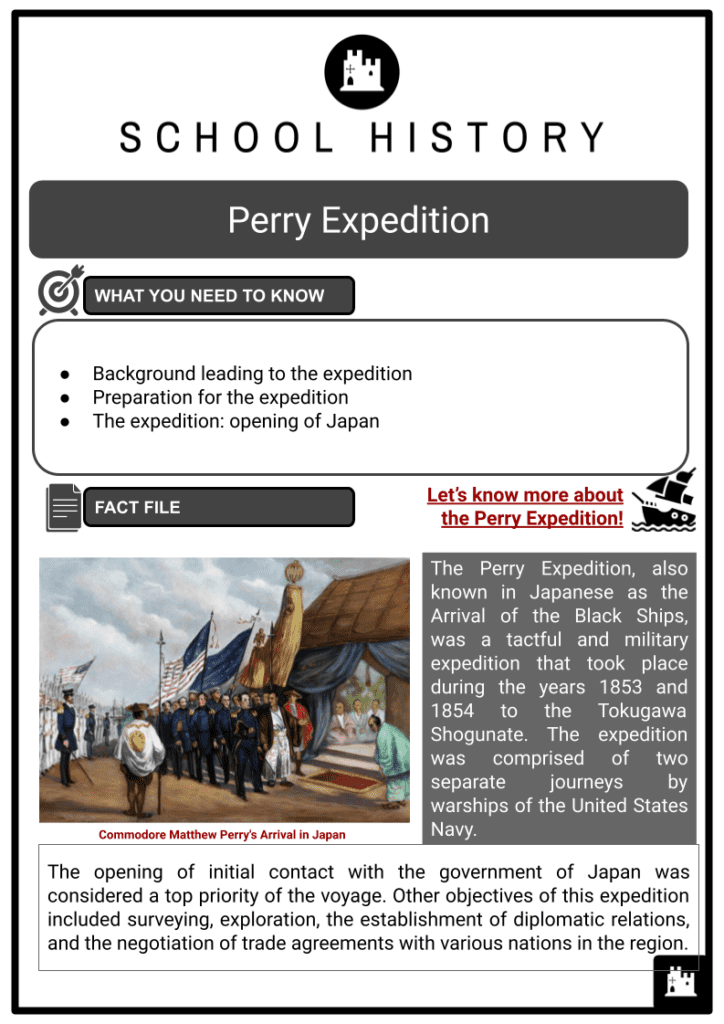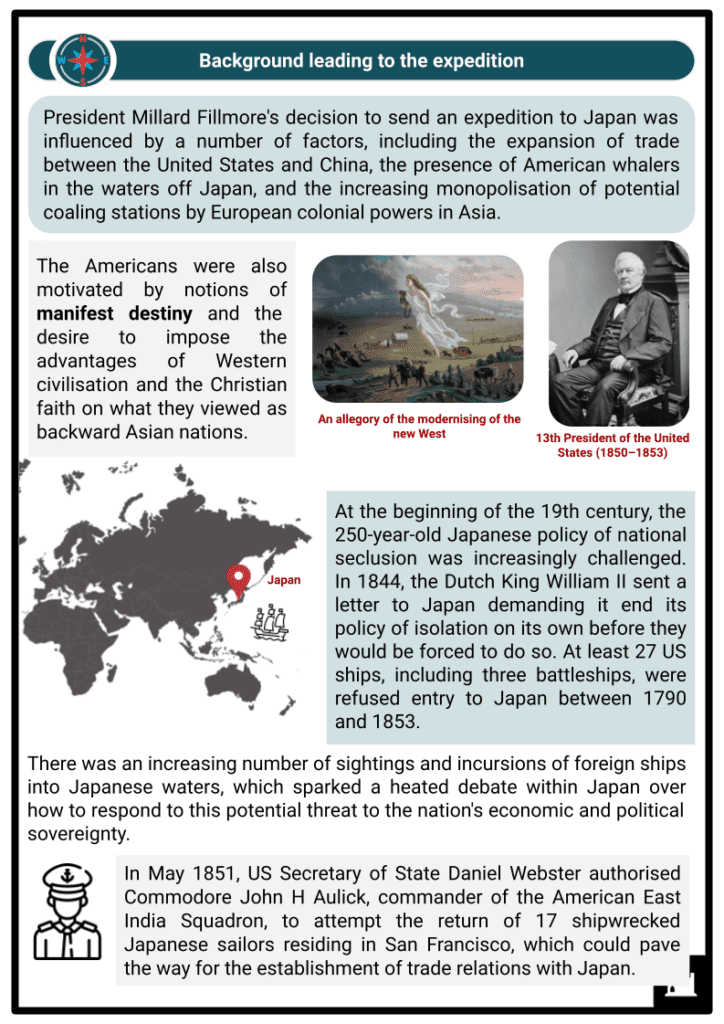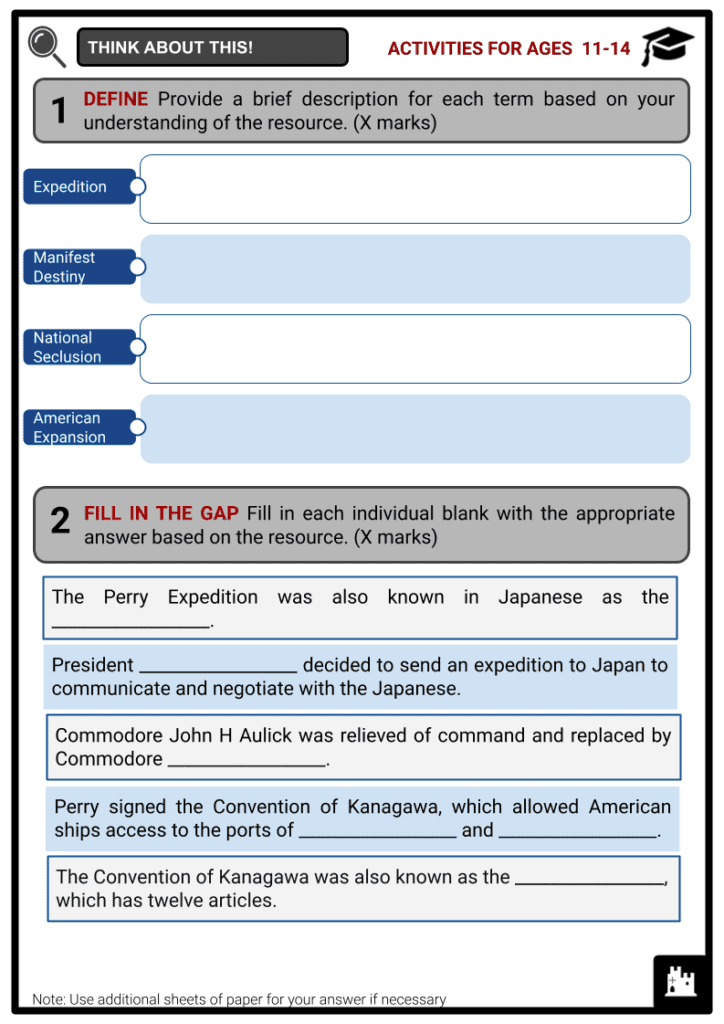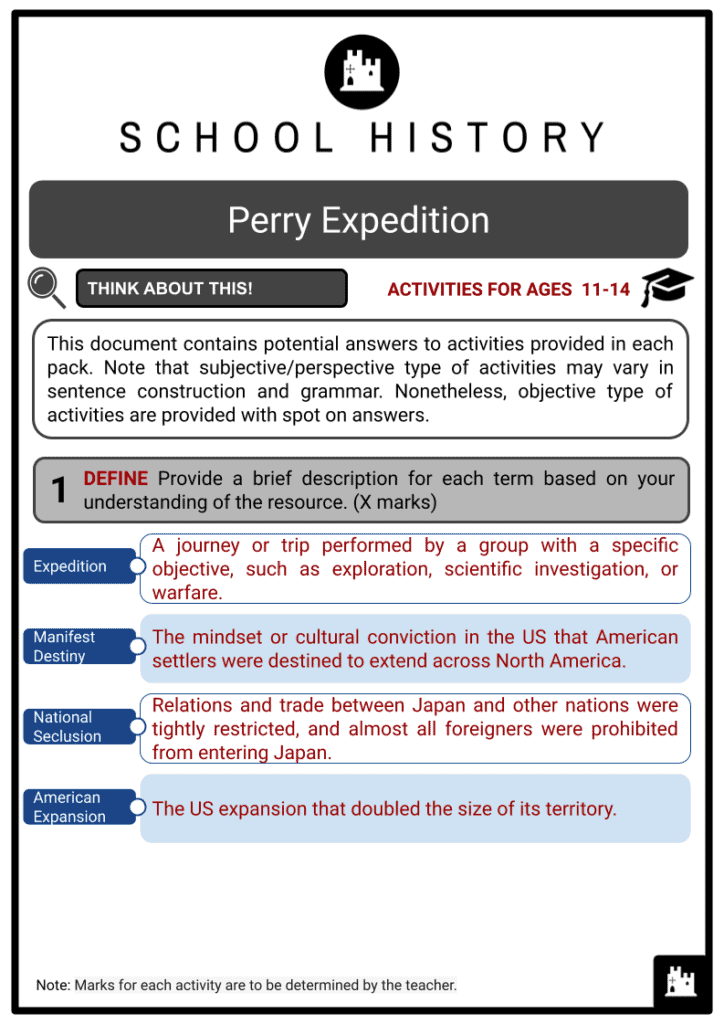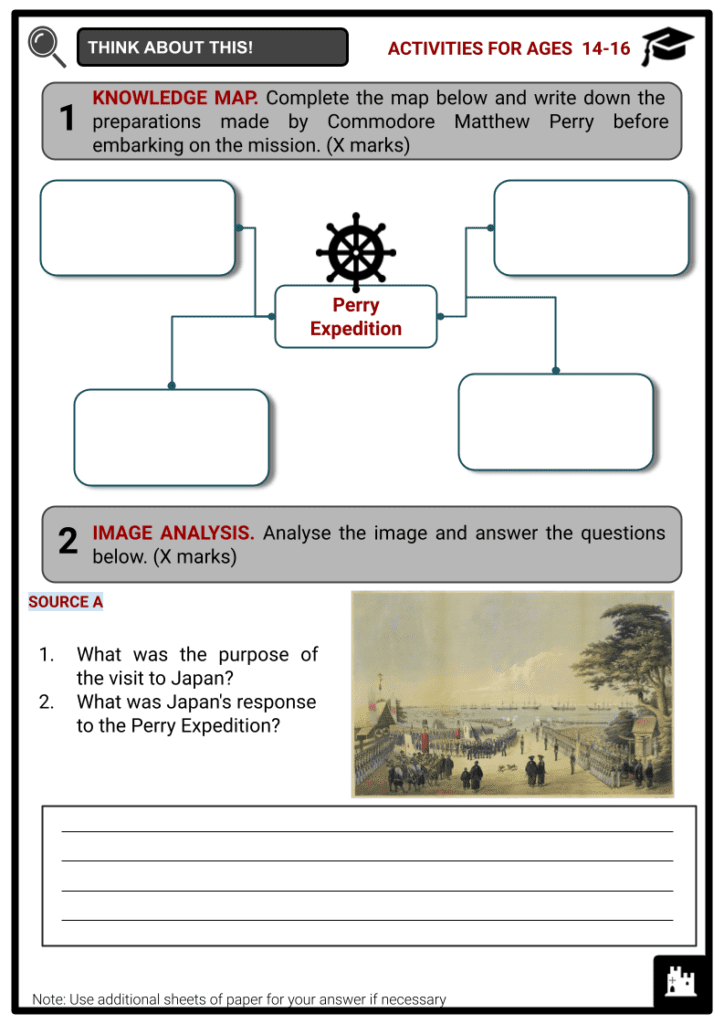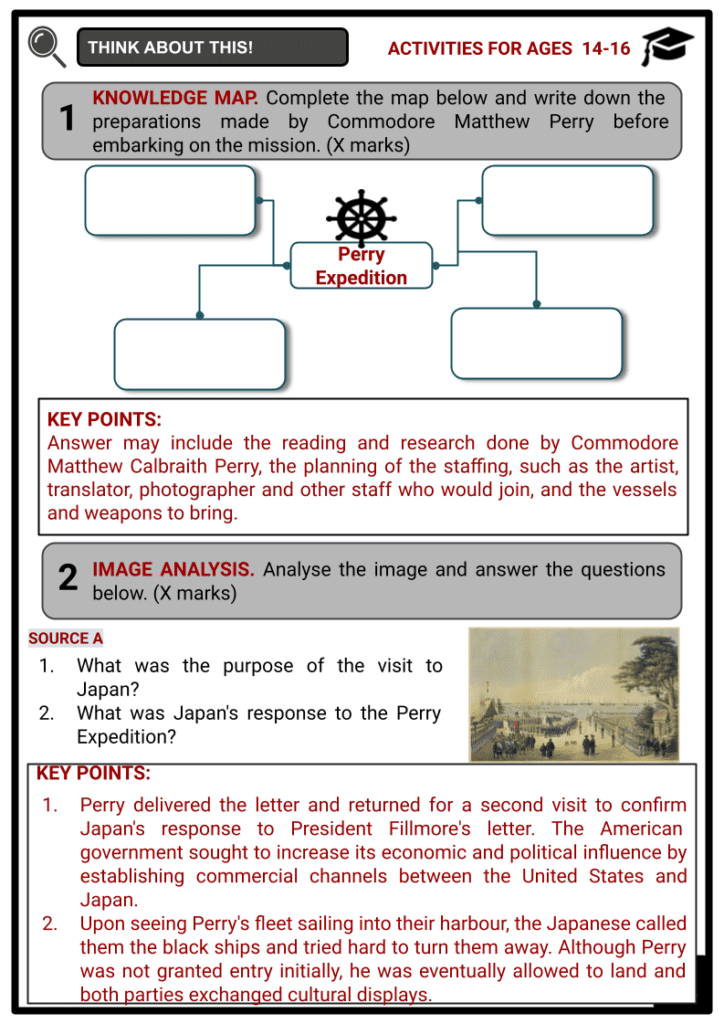Perry Expedition Worksheets
Do you want to save dozens of hours in time? Get your evenings and weekends back? Be able to teach about the Perry Expedition to your students?
Our worksheet bundle includes a fact file and printable worksheets and student activities. Perfect for both the classroom and homeschooling!
Summary
- Background leading to the expedition
- Preparation for the expedition
- The expedition: opening of Japan
Key Facts And Information
Let’s know more about the Perry Expedition!
The Perry Expedition, also known in Japanese as the Arrival of the Black Ships, was a tactful and military expedition that took place during the years 1853 and 1854 to the Tokugawa Shogunate. The expedition was comprised of two separate journeys by warships of the United States Navy. The opening of initial contact with the government of Japan was considered a top priority of the voyage. Other objectives of this expedition included surveying, exploration, the establishment of diplomatic relations, and the negotiation of trade agreements with various nations in the region.
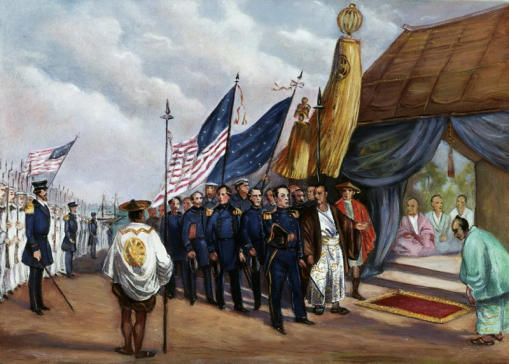
Background leading to the expedition
- President Millard Fillmore's decision to send an expedition to Japan was influenced by a number of factors, including the expansion of trade between the United States and China, the presence of American whalers in the waters off Japan, and the increasing monopolisation of potential coaling stations by European colonial powers in Asia.
- The Americans were also motivated by notions of manifest destiny and the desire to impose the advantages of Western civilisation and the Christian faith on what they viewed as backward Asian nations.
- At the beginning of the 19th century, the 250-year-old Japanese policy of national seclusion was increasingly challenged. In 1844, the Dutch King William II sent a letter to Japan demanding it end its policy of isolation on its own before they would be forced to do so. At least 27 US ships, including three battleships, were refused entry to Japan between 1790 and 1853.
- There was an increasing number of sightings and incursions of foreign ships into Japanese waters, which sparked a heated debate within Japan over how to respond to this potential threat to the nation's economic and political sovereignty.
- In May 1851, US Secretary of State Daniel Webster authorised Commodore John H Aulick, commander of the American East India Squadron, to attempt the return of 17 shipwrecked Japanese sailors residing in San Francisco, which could pave the way for the establishment of trade relations with Japan.
- On 10 May 1851, Webster penned a letter to the Japanese emperor in which he assured the emperor that the expedition's sole objective was to seek 'friendship and commerce' and coal for American ships enroute to China. Signed by President Fillmore, the letter also bragged of American expansion throughout the North American continent and its technical prowess.
- Before he could embark on the Japan expedition, however, Aulick was relieved of command after becoming embroiled in a diplomatic dispute with a Brazilian envoy and quarrels with his flagship's commander. His replacement, Commodore Matthew Calbraith Perry, was a senior officer in the United States Navy with significant diplomatic experience.
Background leading to the expedition
- Perry was well aware of the obstacles involved in seeking to build relations with Japan, and he originally objected to being assigned to yet another endeavour to open Japan, which he viewed as unlikely to succeed.
- Before embarking on his journey, Perry read numerous books about Japan. Consultation with the eminent Japanologist Philipp Franz von Siebold was also part of his research.
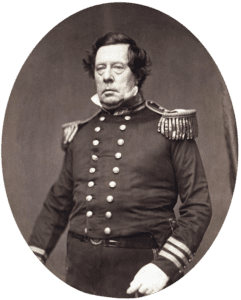
Matthew Calbraith Perry - Siebold spent eight years working, teaching and researching at the remote Dutch island trading colony of Dejima in the port of Nagasaki, Japan.
- In addition, Perry pushed for more discretion in his directives from Webster, which the Secretary of State eventually granted in October 1852.
- Perry therefore sailed to Japan with complete and discretionary authority, including the ability to use force if necessary.
- Perry also denied any professional diplomats from joining the expedition. As official artists, he invited the German painter Wilhelm Heine and the pioneering daguerreotype photographer Eliphalet M Brown, Jr to accompany the voyage.
- The US Department of State assigned agricultural specialist Dr James Morrow. Additionally, several Japanese castaways were employed as unofficial interpreters.
- The Lexington, Supply and Southampton were armed store steamships; the Macedonian, Plymouth and Saratoga were sailing sloops, and the Powhatan, Susquehanna and Mississippi were steam warships assigned to the Perry Expedition.
- When deciding which officers would lead his fleet, Perry looked to his Mexican–American War comrades. Joel Abbot commanded the Macedonian, while Commander Franklin Buchanan was in charge of the Susquehanna.
- Commander Henry A Adams was promoted to the position of Captain of the Fleet and served as the Commodore's chief of staff.
- The highest-ranking marine commander stationed in Mississippi was Major Jacob Zeilin, who would later become commandant of the United States Marine Corps.
- Perry was also given the green light to seize government supplies, including outdated small guns, to give to the natives as gifts.
- They had 100 Colt revolvers, 20 percussion pistols, 20 muskets with Maynard percussion locks, 20 artillery swords, 40 light cavalry sabres and 4,000 rounds for 40 M1819 Hall rifles.
The expedition: opening of Japan
First voyage to Japan, 1852–1853
- 24 November 1852. The steam-powered Mississippi was Perry's flagship of choice and embarked from Norfolk, Virginia.
- Perry made port calls at Madeira (11–15 December), Saint Helena (10–11 January), Cape Town (24 January – 3 February), Mauritius (18–28 February), Ceylon (10–15 March), Singapore (25–29 March), Macao and Hong Kong (7–28 April), where he met American-born Sinologist Samuel Wells Williams, who provided Chinese language translations of his official letters and met with the Plymouth ship.
- He proceeded to Shanghai (4–17 May), where he met the Dutch-born American ambassador Anton L C Portman, who translated his official letters into Dutch, and where the Susquehanna joined.
- 17 May 1853. Perry subsequently changed his flag to the Susquehanna and visited the Ryukyu islands between 17 and 26 May. Ignoring Satsuma Domain's and his own claims to the islands, he pressured and bluffed local authorities by threatening to attack with 200 troops if he was not granted trading privileges and land for a coaling station.
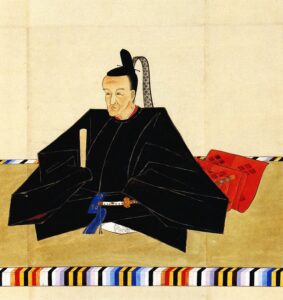
Tokugawa Ieyoshi - Perry continued to the Ogasawara islands in mid-June, where he met the locals and acquired a piece of land.
- On 8 July 1853, Perry reached Uraga at the entrance to Edo Bay in Japan. His decisions at this critical juncture were based on a thorough examination of Japan's previous interactions with Western ships and his knowledge of Japanese hierarchical culture.
- As he arrived, Perry commanded his ships to steam through the Japanese lines towards the capital of Edo and to aim their cannons at the town of Uraga. Perry resisted Japanese requests to depart or travel to Nagasaki, the only Japanese port accessible to foreigners.
- Perry attempted to scare the Japanese by presenting them with a white flag and a letter threatening their destruction if they chose to fight. He also fired blank rounds from his 73-calibre cannon, which he claimed was in honour of the American Independence Day.
- During this time, Shōgun Tokugawa Ieyoshi was unwell and unable to make decisions, resulting in government confusion regarding how to respond to the unprecedented threat to the nation's capital.
- 11 July 1853. Rōjū Abe Masahiro waited it out on 11 July after deciding that getting a letter from the US would not violate Japanese sovereignty.
- Uraga was informed of the decision, and on 14 July 1853 Perry was given permission to dock at the beach of Kurihama to deliver the President's letter.
- Perry then left for Hong Kong, promising to return the following year to get the Japanese response to the letter he presented.
Second voyage to Japan, 1854
- On 13 February 1854, Perry returned with eight warships and 1,600 troops. In addition to Lexington, Macedonian, Powhatan, Vandalia and Southampton, the fleet now lacked Plymouth, one of the four original ships. On 19 March, a shipment of coal and supplies arrived, boosting the total strength to nine.
- When Perry arrived, each party gave a performance. The Americans put on a presentation of their cutting-edge technology such as a telegraph apparatus, model of a steam locomotive, and various agricultural tools, while the Japanese put on a sumo wrestling show.
- By the time Perry returned, the Tokugawa shogunate had decided to accept nearly all of Fillmore's letter's demands. However, negotiators procrastinated for weeks over the location of the negotiations, with Perry insisting on Edo and the Japanese proposing a variety of other sites.
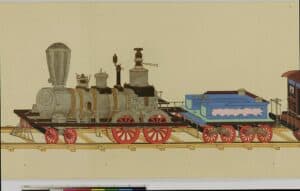
A model steam locomotive that was presented to the Japanese - On 31 March, Perry signed the Convention of Kanagawa, which allowed American ships access to the ports of Shimoda and Hakodate, established an American consulate in Shimoda, and guaranteed the welfare of shipwrecked sailors.
- Hayashi Akira signed the treaty on behalf of the Japanese. Perry then sent the Saratoga home with the signed treaty, while the remainder of the squadron surveyed Hakodate, Shimoda and the planned consulate site.
- After leaving Shimoda, the navy returned to the Ryukyu Islands, where Perry prepared and signed the Compact between the United States and the Ryukyu Kingdom on 11 July 1854.
The Treaty
- The Convention of Kanagawa was also known as the Japan US Treaty of Peace and Amity, which has twelve articles. The treaty was ratified on 21 February 1855.
- I Peace between the United States and the Japanese Empire
- II Opening of the ports of Shimoda and Hakodate
- III American sailors in distress will receive aid
- IV Sailors who are shipwrecked should not be imprisoned or mistreated
- V Freedom of mobility at treaty ports for temporary foreign residents
- VI Trade transactions will be allowed
- VII Allow currency exchange to facilitate all commercial transactions
- VIII Japanese government to have a monopoly on supplying American ships
- IX Japan must grant the United States any favourable advantages that Japan may negotiate in the future with any other foreign country.
- X Prohibiting the United States from using ports other than Shimoda and Hakodate
- XI The opening of a US consulate in Shimoda
- XII The treaty must be ratified within 18 months of its signing
Return to the US
- In recognition of Perry's efforts in Japan, Congress voted to award him $20,000 when he returned to the United States.
- A portion of the funds was used to compile and publish a three-volume account of the journey.
- In recognition of his service in the Far East, he was promoted to rear admiral on the retired list.

